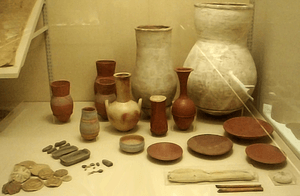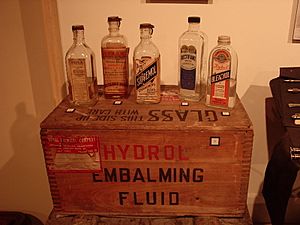Embalming facts for kids
Embalming is a way to preserve a dead body so it doesn't decompose (decay) quickly. If a body isn't embalmed, it starts to decay very fast. This is why bodies are often embalmed if they will be shown at a funeral, like when someone is lying in state. Embalming is a bit like mummification, which was done by many ancient people. However, embalming is different from taxidermy, where only the skin of an animal is preserved.
Contents
The History of Embalming
Ancient Mummification Practices
The oldest preserved bodies ever found were mummified around 5000-6000 BCE. These bodies are known as the Chinchorro mummies. Ancient people who lived in the Atacama desert in what is now Chile and Peru mummified them.
The ancient Egyptians often mummified dead bodies. They started doing this as early as 3200 BCE. They believed that once a body was mummified, its soul could return. This would allow the soul to begin its journey to the afterlife.
Early Embalming Around the World
Ancient cultures in places like Ethiopia, Peru, Tibet, and southern Nigeria also used embalming methods. The Guanches, the Jivaro Indians, the Aztecs, the Toltecs, and the Mayans also practiced it.
In ancient Europe, preserving dead bodies was less common. The oldest known preserved bodies in Europe are about 5000 years old. These bodies were covered in cinnabar to keep them from decaying. They were found in Osorno, Spain. Embalming was unusual in Europe until the time of the Roman Empire.
Archaeologists have found preserved bodies in China from the Han dynasty (206 BCE – 220 ACE). No one knows exactly how these bodies were preserved.
Embalming in the Middle Ages and Renaissance
By about 500 ACE, knowledge about preserving bodies had spread. Embalming became much more common in Europe. This happened partly because science and medicine were growing. Scientists needed to dissect dead bodies to learn about the human body. If bodies were not preserved, they would decay too quickly. This made it hard for scientists to study them.
Modern Embalming Methods Emerge
The English physician William Harvey created the modern way of embalming in the 17th century. This method involves injecting chemicals into a dead body's arteries. This helps to stop the body from decaying.
Until the mid-18th century, embalming was mostly used in science and medicine. However, in the mid-18th century, the Scottish surgeon William Hunter used Harvey's methods. He preserved bodies in morgues. His brother, John Hunter, was the first to offer embalming to regular people. They wanted to see their loved ones' bodies preserved after death.
Embalming in the 19th Century
In the 19th century, more people became interested in embalming dead friends and relatives. For example, sometimes a person might want to be buried far away. But first, their family would want to see their body and say goodbye. Embalming made this possible because the body would not decay during the trip.
In the United States, embalming became very common during the Civil War. Many soldiers died far from home. Their bodies needed to be sent back for burial. Embalming kept their bodies from decaying during these long journeys. When President Abraham Lincoln was killed, embalming allowed his body to be sent home. This made many people in the United States more aware of embalming.
In the past, if someone died from an infectious disease, their body was buried very quickly. This was to stop the disease from spreading. Embalming became a way to help prevent diseases from spreading.
By the mid-19th century, businesses started offering funerals and burials. The people who ran these businesses were called undertakers. Today, they are called funeral directors. These people began using embalming methods regularly. They stopped using older methods like packing bodies in ice.
Embalming in Modern Times
Until the early 20th century, arsenic was often used to embalm bodies. Later, other chemicals replaced it. These new chemicals worked better and were less poisonous. In 1867, the German chemist August Wilhelm von Hofmann discovered formaldehyde. Scientists soon realized this chemical worked very well to preserve dead bodies. Formaldehyde quickly became the most common chemical used for embalming.
Religious Views on Embalming
Different religions have many different ideas about embalming. Some religions allow embalming, while others do not.
Religions that usually allow embalming include:
- Buddhism
- Most branches of Christianity
- The Church of Jesus Christ of Latter-Day Saints (Mormons)
- Hinduism
- The Society of Friends (Quakers)
Some religions, like some Neopagan religions, don't encourage embalming, but they don't forbid it either.
Some religions say that embalming is never allowed. These religions include:
- The Bahá'í Faith
- Islam and Judaism (unless laws require bodies to be embalmed)
- Zoroastrianism
Related pages
Images for kids
-
William Hunter developed and popularized the modern technique of arterial embalming in the late 18th century.
See also
 In Spanish: Embalsamamiento para niños
In Spanish: Embalsamamiento para niños






